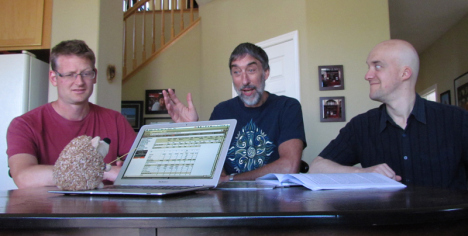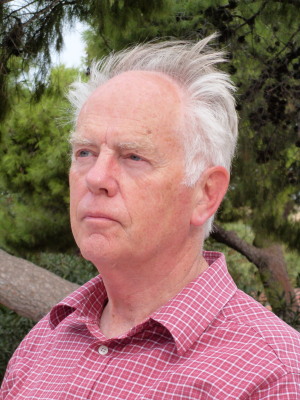I’ve been travelling internationally for the last few weeks. It’s been a productive time – I’ve drafted a complete paper intended for The Breakthrough Journal (more on this in a later post), increased and enhanced my network of professional connections and friendships, got some robust strategic planning done on how to get ‘big things’ happening in energy and ecology, and generally had a fun time!
First, I was in St Petersburg, Russia, for the awards ceremony of the Global Energy Prize. (Whilst there I saw a performance of Swan Lake at the Alexandrinksy Theatre).
Then I visited Chicago for a few days at the annual meeting of the American Nuclear Society, where we had a full-day workshop on the Integral Fast Reactor, including insights from some of the key engineers (Charles Till, Yoon Chang, Len Koch, Mike Lineberry, John Sackett), followed by some environmental and international perspectives from Joe Shuster, Tom Blees, Mark Lynas and me.
Over the last few days I was in Sausilito for the 2012 Breakthrough Dialogue (here is a link to the 2011 meeting) on dealing with ‘wicked problems’ (energy and biodiversity related) — apart from a great meeting, I got to walk around the beautiful surrounding landscapes of pine (and eucalypt!), and across the Golden Gate Bridge before the typical San Francisco fog started to roll in.
Oh, I also stayed with Tom Blees for a day in Sacramento, along with Mark Lynas – whilst there, we got some education in energy policy from Hobo the Hedgehog (courtesy of Dave Blees):
Now, I’m in downtown San Francisco with Ben Heard, preparing to head home tonight. (By the way, check out John Morgan’s report on Ben’s recent nuclear debate in Sydney).
Some other things of general interest, before I sign off:
Here is an interview (PART 1, PART 2) I did on nuclear energy on 5aa radio on the need for nuclear energy, on world environment day this year.
An interesting snippet sent to me by Steve Kirsch:
The head (or former head) of the radiation protection division of U.S.-NRC once stated (jokingly) at an IAEA reception in Vienna: There are three types of photons, namely ‘green’ ones, ‘yellow’ ones and ‘red’ ones.
The ‘green’ ones are plentiful and of natural origin. We are not concerned about them and we don’t regulate them.
The ‘yellow’ ones come from medical applications. They are usually less plentiful, but we are a bit concerned about them and thus we regulate them somewhat.
The ‘red’ ones are very rare, they find their origin in nuclear energy applications. We are very concerned about them and consequently we regulate the hell out of them.
A comedy skit which summarizes my view on ‘alternative medicine’:
Finally, when I Chicago, I had dinner with Wade Allison, Oxford Don and author of the book “Radiation and Reason” (I read it on Kindle recently, and highly recommend it). If you want an overview of the message in the book, download his overview pamphlet (PDF here). Here is the brief:
Public Trust in Nuclear Energy
Wade Allison, Emeritus Professor of Physics at the University of Oxford and Fellow of Keble College, Oxford, Author of “Radiation and Reason: The Impact of Science on a Culture of Fear” (2009)
Contents: Summary – Introduction – Personal interlude – Physical nuclear safety in nature – Radiation doses for medical health – Hidden biological radiation protection – Of Hiroshima and Nagasaki – Towards a fresh view of radiation protection regulation – Doses, food, evacuation and lessons unlearnt – Our mistake, our correction, our survival
A list of the pros and cons of nuclear energy is straightforward; we need it, it is safe, but people are frightened of it. The need to replace fossil fuels with another large base-load source is widely understood and the safety of the nuclear solution has been demonstrated many times; even in accidents in which reactors suffer irreparable damage, the impact on human health has been minimal. For example, at Fukushima there has been no death, or even extended hospitalisation, due to radiation, nor is this likely to be responsible for any cancer deaths in 50 years.
 The reasons for the fear of radiation are instinctive and historical. It is natural to shun what is powerful and unseen, and the legacy of the Cold War with its weapon of nuclear fear has added to that. Although the public accepts moderate to high doses of radiation when used benignly for their own health, non-medical international safety standards are set extremely low to appease popular concerns – these specify levels found in nature or as low as reasonably achievable (ALARA). Yet modern biology and medicine confirm that no harm comes from radiation levels up to 1000 times higher and realistic safety levels could be set as high as relatively safe (AHARS). Indeed the local damage to public health and the social economy caused by ALARA regulations imposed at Chernobyl and Fukushima has been extremely serious and without benefit.
The reasons for the fear of radiation are instinctive and historical. It is natural to shun what is powerful and unseen, and the legacy of the Cold War with its weapon of nuclear fear has added to that. Although the public accepts moderate to high doses of radiation when used benignly for their own health, non-medical international safety standards are set extremely low to appease popular concerns – these specify levels found in nature or as low as reasonably achievable (ALARA). Yet modern biology and medicine confirm that no harm comes from radiation levels up to 1000 times higher and realistic safety levels could be set as high as relatively safe (AHARS). Indeed the local damage to public health and the social economy caused by ALARA regulations imposed at Chernobyl and Fukushima has been extremely serious and without benefit.
Global damage to future prospects for nuclear power is avoidable. Public trust in nuclear energy should be rebuilt on the existing acceptance of beneficial clinical radiation dose levels through a programme of open and explanatory public education at all levels. Science, not the result of litigation or a popular political vote, is the only firm basis for radiological safety and genuine reassurance. The international authorities (ICRP, UNSCEAR and IAEA) should change the philosophy of their recommendations in order to relate to real dangers (ALARA to AHARS), which would ensure that the world does not continue to be “spooked” by the one major energy source that could support future economic stability without damage to the environment.
————————-
To register comments for this post, go HERE to the BraveNewClimate Discussion Forum.






.png)








To register comments, go here:
http://bravenewclimate.proboards.com/index.cgi?action=display&board=bncblogposts&thread=280
[…] his recent US of A report Barry Brook shared a quote from Steve […]